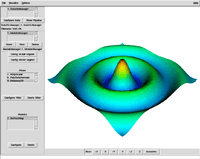MayaVi
 | |
|
A screenshot of the main window, with an example visualization | |
| Original author(s) | Prabhu Ramachandran |
|---|---|
| Developer(s) | Enthought |
| Initial release | 2001 |
| Stable release |
4.4.0
/ January 15, 2015 |
| Development status | Active |
| Written in | Python, VTK, WxPython/Qt |
| Operating system | GNU/Linux, Mac OS X, Microsoft Windows |
| Available in | English |
| Type | Data visualization |
| License | BSD License |
| Website |
code |
MayaVi is a scientific data visualizer written in Python, which uses VTK and provides a GUI via Tkinter. MayaVi was developed by Prabhu Ramachandran, is free and distributed under the BSD License. It is cross-platform and runs on any platform where both Python and VTK are available (almost any Unix, Mac OS X, or Windows). MayaVi is pronounced as a single name, "Ma-ya-vee", meaning "magical" in Sanskrit. The code of MayaVi has nothing in common with that of Autodesk Maya or Vi.[1]
The latest version of MayaVi, called Mayavi2, is a component of the Enthought suite of scientific Python programs. It differs from the original MayaVi by its strong focus on making not only an interactive program, but also a reusable component for 3D plotting in Python. Although it exposes a slightly different interface and API than the original MayaVi, it now has more features.[2][3]
Major features
- visualizes computational grids and scalar, vector, and tensor data
- an easy-to-use GUI
- can be imported as a Python module from other Python programs or can be scripted from the Python interpreter
- supports volume visualization of data via texture and ray cast mappers
- support for any VTK dataset using the VTK data format
- support for PLOT3D data
- multiple datasets can be used simultaneously
- provides a pipeline browser, with which objects in the VTK pipeline can be browsed and edited
- imports simple VRML and 3D Studio scenes
- custom modules and data filters can be added
- exporting to PostScript files, PPM/BMP/TIFF/JPEG/PNG images, Open Inventor, Geomview OOGL, VRML files, Wavefront .obj files, or RenderMan RIB file
References
External links
- mayavi on GitHub
- MayaVi on SourceForge.net
